Test it for free, or get in touch if you’d prefer to chat.
Fancy giving Distribution Engine a try?
Have a play around for free, or get in touch if you’d prefer to chat.
What is Lead Routing in Sales? How to Optimize Your Sales Process.
Key takeaways:
Lead routing, defined. Automated assignment based on signals that matter — territory, product interest, company size, skills, availability.
Why it matters. Faster speed-to-lead. Fewer handoffs. More selling time. Cleaner first impressions.
When it breaks. Cold leads. Duplicate outreach. Reassignments. Uneven workloads.
What “good” looks like. Clean capture, clear rules, real-time automation, and visibility to tune.
How to get there. Start simple. Layer strategies as you learn. Use Salesforce-native tooling so the process lives where your team works.
A strong lead lands in Salesforce. But ownership is fuzzy, so it sits waiting to be assigned. By the time the right sales rep gets to it, the moment’s gone. Sales teams are doing their best, yet the system makes being fast harder than it should be.
That’s the problem lead routing is meant to solve.
A dependable automated lead routing solution gets each lead to the best team member immediately. One name. One task. A quick, relevant first touch. When this works, you feel it: faster responses, calmer queues, and fewer “almost” deals.
What Is Lead Routing?
Lead routing or lead assignment directs an inbound lead to the best-fit salesperson the moment it’s created. Use cases can be simple: round robin across the Sales Development Team. However, it is often more layered: UK healthcare leads interested in Product A go to the EMEA health team; if capacity is hit, overflow to a backup pool; if state is missing, infer it from dial code so nothing stalls.
The goal of an efficient lead routing process isn’t clever rules. It’s reliability, speed and accountability.
Salesforce-native tools like NC Squared’s Distribution Engine make this practical. Rules are click-to-edit. High-value leads land with the right person in seconds, not hours. Less triage. Fewer errors. More conversations while intent is still high.
Why Lead Management Matters.
Speed shapes everything with new leads. Quick replies lead to better first calls. Better first calls lead to shorter cycles and more qualified leads. You’ll feel the compound effect in pipeline quality and forecast confidence.
There’s a human side, too. Reps work real opportunities instead of fixing ownership. Managers' workflows allow for coaching instead of refereeing fairness debates. Workloads feel fair because they are. The result is momentum - the kind that shows up in both potential customer conversion rates and morale.
Teams that tighten speed-to-lead and match leads to specialists often set sub-10-minute response times as the norm, not the exception.
The Cost of Poor Lead Distribution.
When assignment lags, good leads cool off. Sales reps burn time on reassignments or chase the wrong targets. Incoming leads get two follow up calls, or none. Over time, uneven distribution eats at trust: some reps drown; while others feel left out.
Lead routing software like Distribution Engine helps by balancing load and respecting capacity. Caps prevent overload. Overflow rules keep queues moving when a team hits its limit. Momentum survives busy days and campaign spikes all while allowing your team to maintain the customer experience.
Core Components of an Effective Lead Routing System.
1) Lead capture and qualification
Great routing starts with great inputs. Standardise the fields you depend on (geo, segment, product interest, account size) and enrich early so the first owner has context. Lead routing tools can classify and enrich at capture, which keeps unqualified records out of queues and avoids guesswork on the first call.
2) Defined lead routing rules
Clarity beats complexity. Build rules around territory, product, company size, lead score, language, skills, and availability. You’ll want the freedom to update logic without code when territories shift, new products launch, or teams reorganise - an area where Distribution Engine is far more flexible than rigid Salesforce assignment rules or custom Apex flows.
3) Automated routing
Manual triage doesn’t scale. Automated lead routing assigns in real time, applies fairness controls (round-robin, caps, availability windows), and can auto-reassign if a lead sits untouched past an SLA. The playbook becomes reliable, not heroic.
4) Performance monitoring
“Set and forget” is how systems decay. Logs, dashboards, and SLA tracking let RevOps see what’s happening, tune rules, and prove impact. If you can see the bottlenecks - slow queues, frequent reassignments, idle capacity - you can remove them.
Lead Routing Best Practices to Maximise Sales Potential.
Geographic Routing: Meeting Prospects Where They Are.
What is it: Assign leads by geographic location (e.g., country, state, or region) so reps with local knowledge handle local prospects, aligning with time zones, local norms, and regulations.
If data is patchy, tools like Distribution Engine use territory classifiers that can fill in the gaps (such as state from dial codes) to keep assignments accurate without manual cleanup.
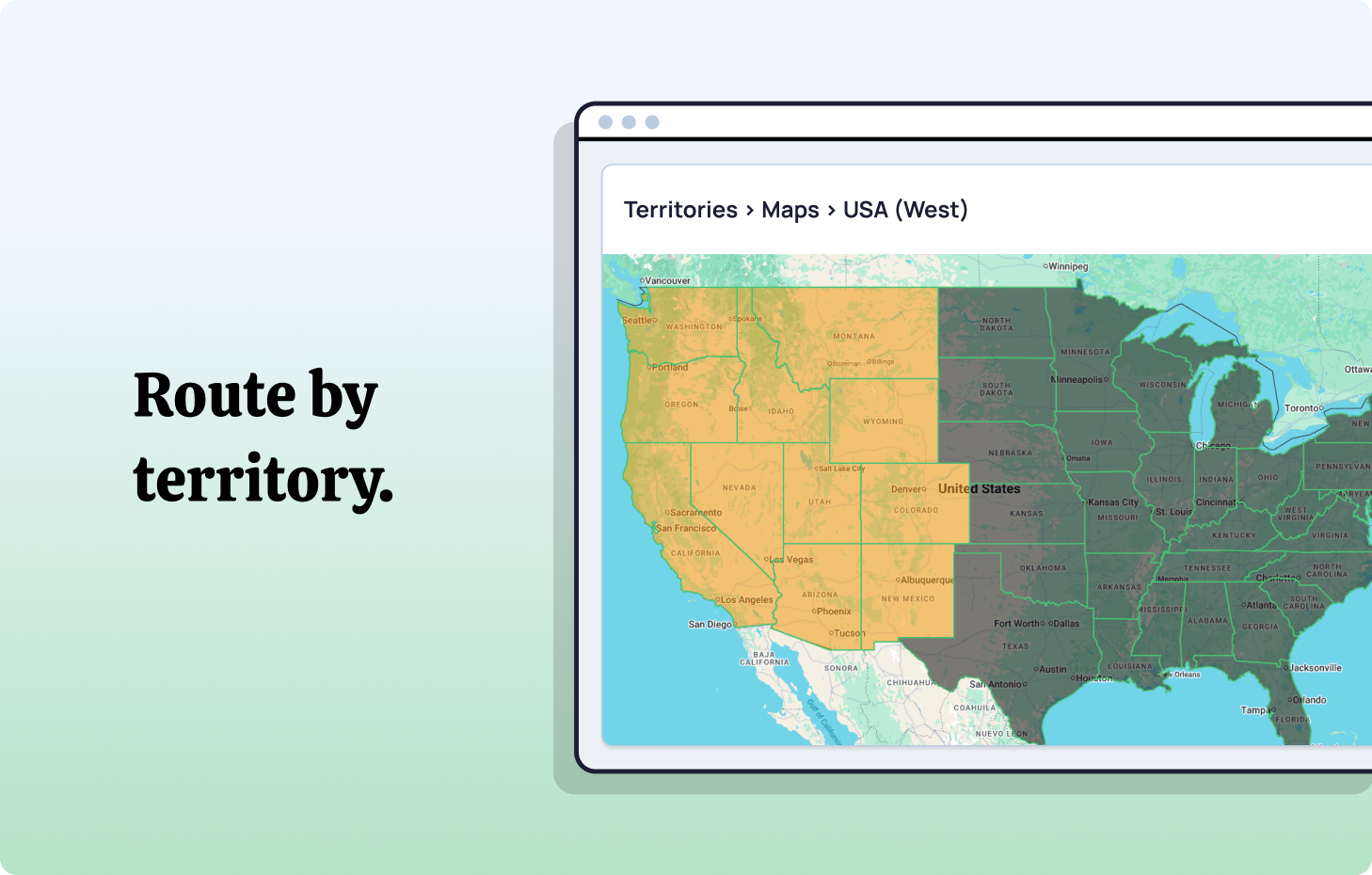
Industry/Niche Routing: Specialization Builds Trust.
What is it: Healthcare to healthcare. Finance to finance. Matching buyers with someone fluent in their world shortens discovery and raises confidence on both sides.
[Product Visualisation]
Company Size/Revenue Routing: Aligning Complexity with Expertise.
What is it: SMB prospects move faster and need different handling than large enterprises. Routing by company size ensures smaller accounts go to speed-oriented reps, while enterprise deals land with senior account executives who can manage longer, complex cycles.

Skill-Based Routing: Leveraging Strengths.
What is it: Some leads require specific skills - like language fluency, technical depth, or strong negotiation experience. Routing by skill ensures the right conversations happen from the start, especially in global or highly technical sales environments.
Company Size/Revenue Routing: Aligning Complexity with Expertise.
What is it: SMB prospects move faster and need different handling than large enterprises. Routing by company size ensures smaller accounts go to speed-oriented reps, while enterprise deals land with senior account executives who can manage longer, complex cycles.
Lead Score Routing: Prioritizing High-Intent Prospects.
What is it: Not all leads are equal. Prospects showing a high degree of intent or are a perfect match for your ideal customer profile should go straight to top reps who can close them, while lower-score leads may go to SDRs for nurturing. Distribution Engine uses CRM and marketing automation scores to prioritize assignments, so your best talent focuses where it counts.
Round-Robin Routing: Keeping It Fair.
What is it: Spread leads evenly to keep the team motivated and avoid cherry-picking. Distribution Engine enhances this classic model with workload caps and performance tags so top performers stay protected from overload while fairness is preserved.
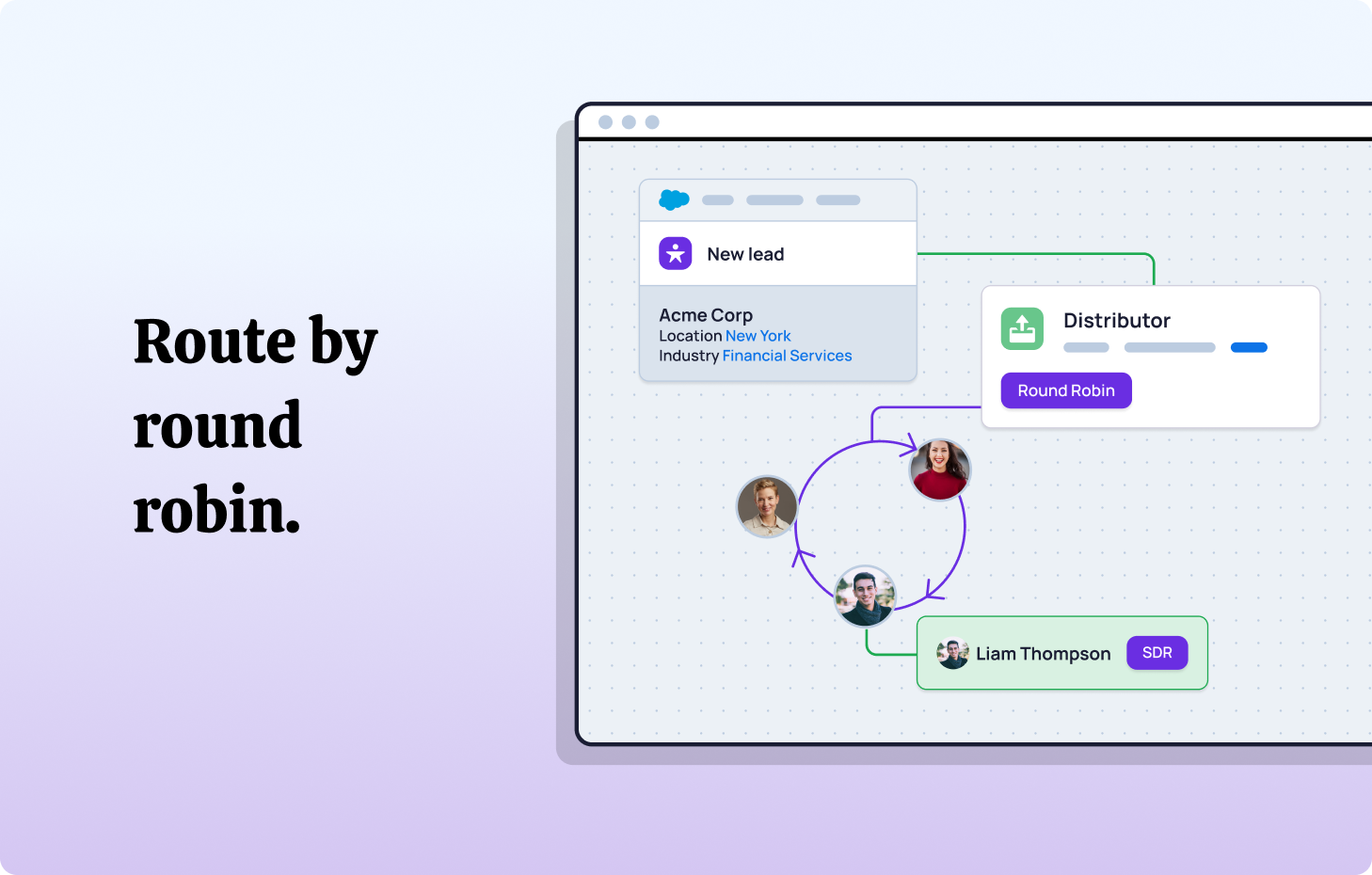
Capacity.
What is it: Assign new leads to the best-fit rep only when they’ve got room to work them. Distribution Engine checks real-time workload, then applies caps you define, like “Working” leads, tasks due today, active SLAs, or daily/hourly limits. If a rep hits their cap, the next qualified rep gets the record. As they clear work, they’re eligible again. Works with your existing rules for interest, score, skill and availability. Capacity is the final gate that keeps follow-up fast.
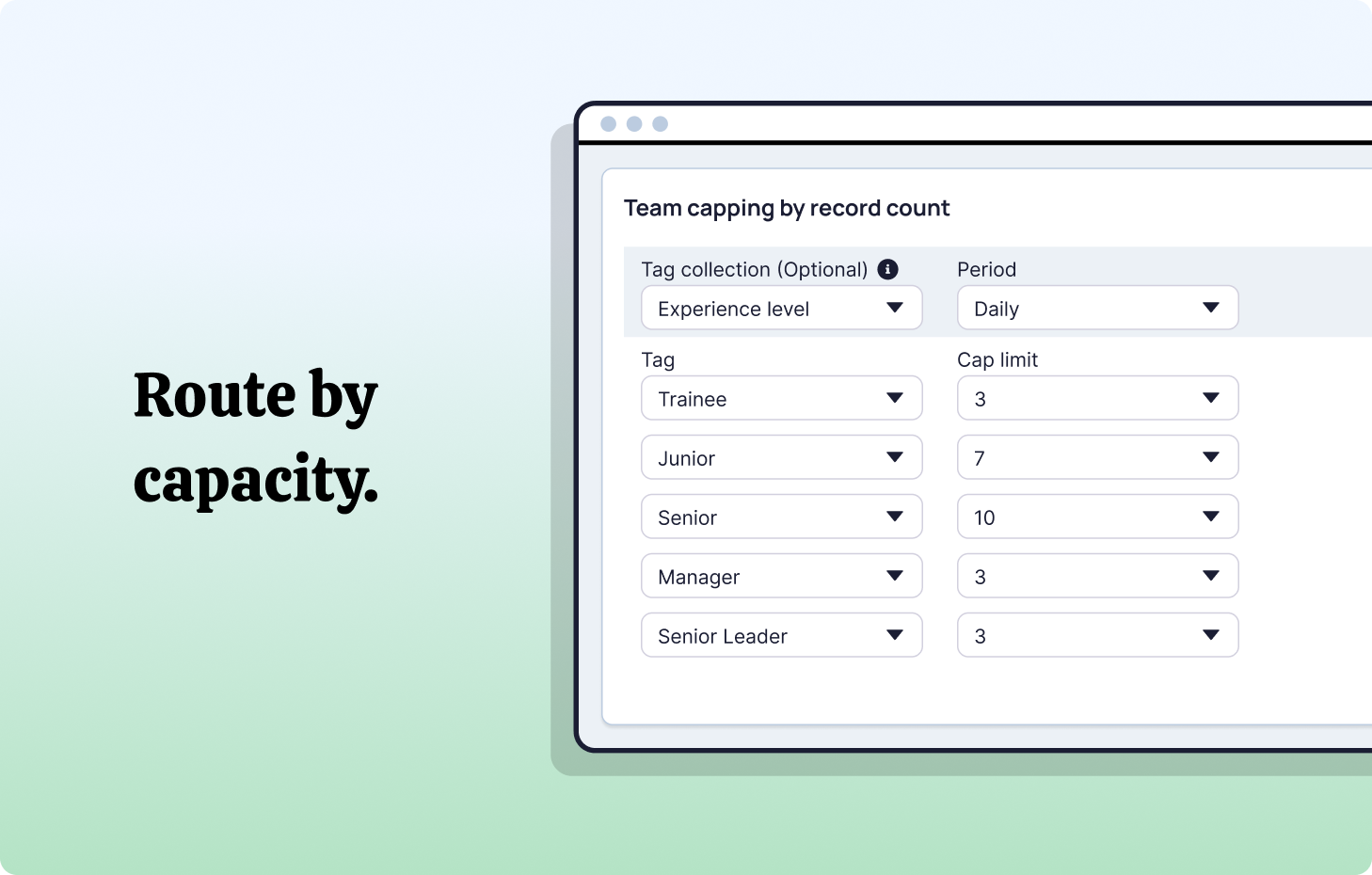
Availability.
What is it: Route leads to reps who are available and ready to take the lead right away. Avoid missed opportunities by routing leads to reps who are available and ready to respond right away. Factor in vacations, sick leave and shift patterns, and stop leads going unworked.
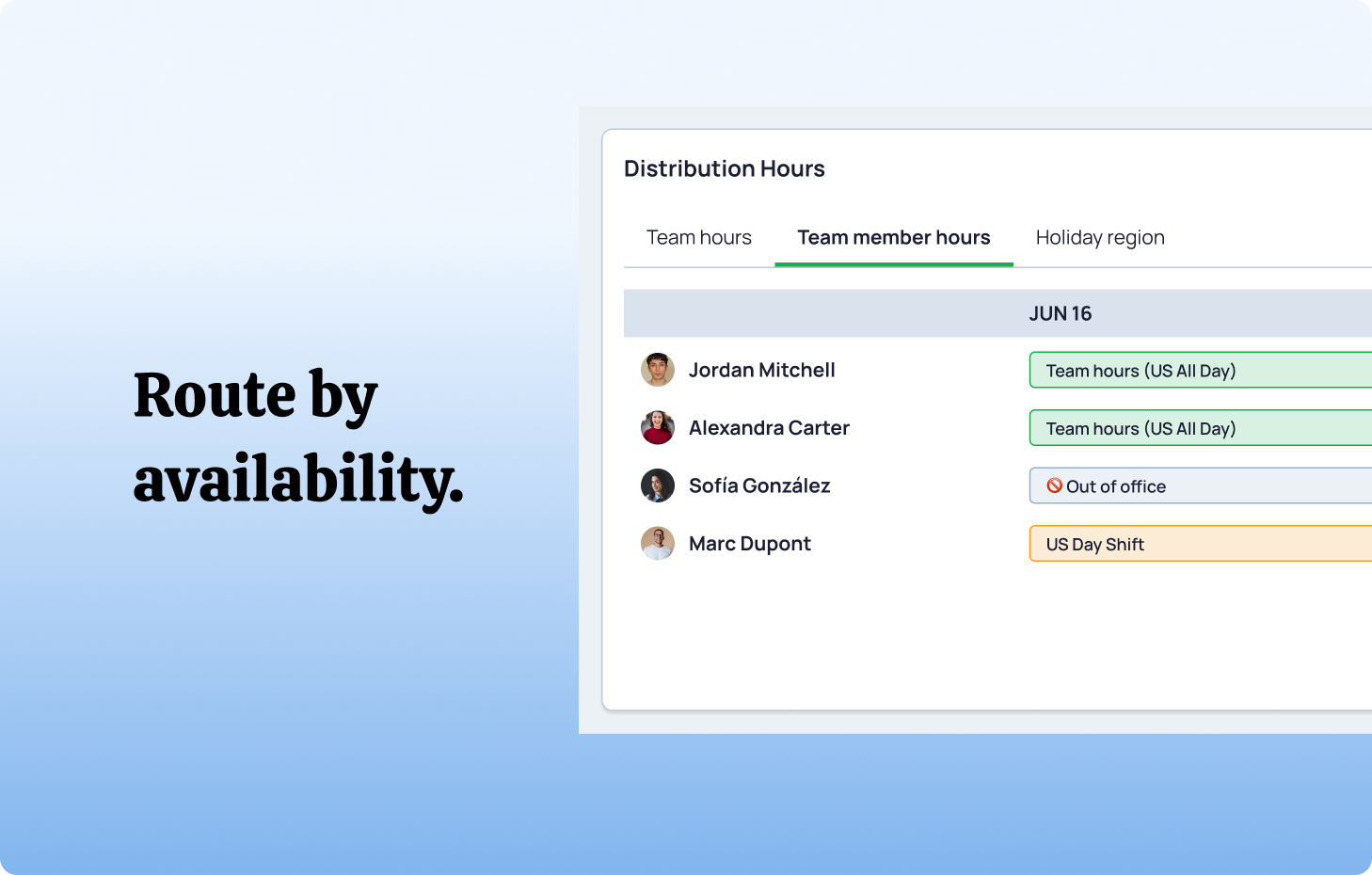
Hybrid models.
What is it: Most organizations mix two or more of these strategies. For example, leads might first be sorted by territory, then by product interest, and finally assigned round-robin within the qualified pool. Distribution Engine makes layering rules simple, giving RevOps leaders flexibility without added complexity.
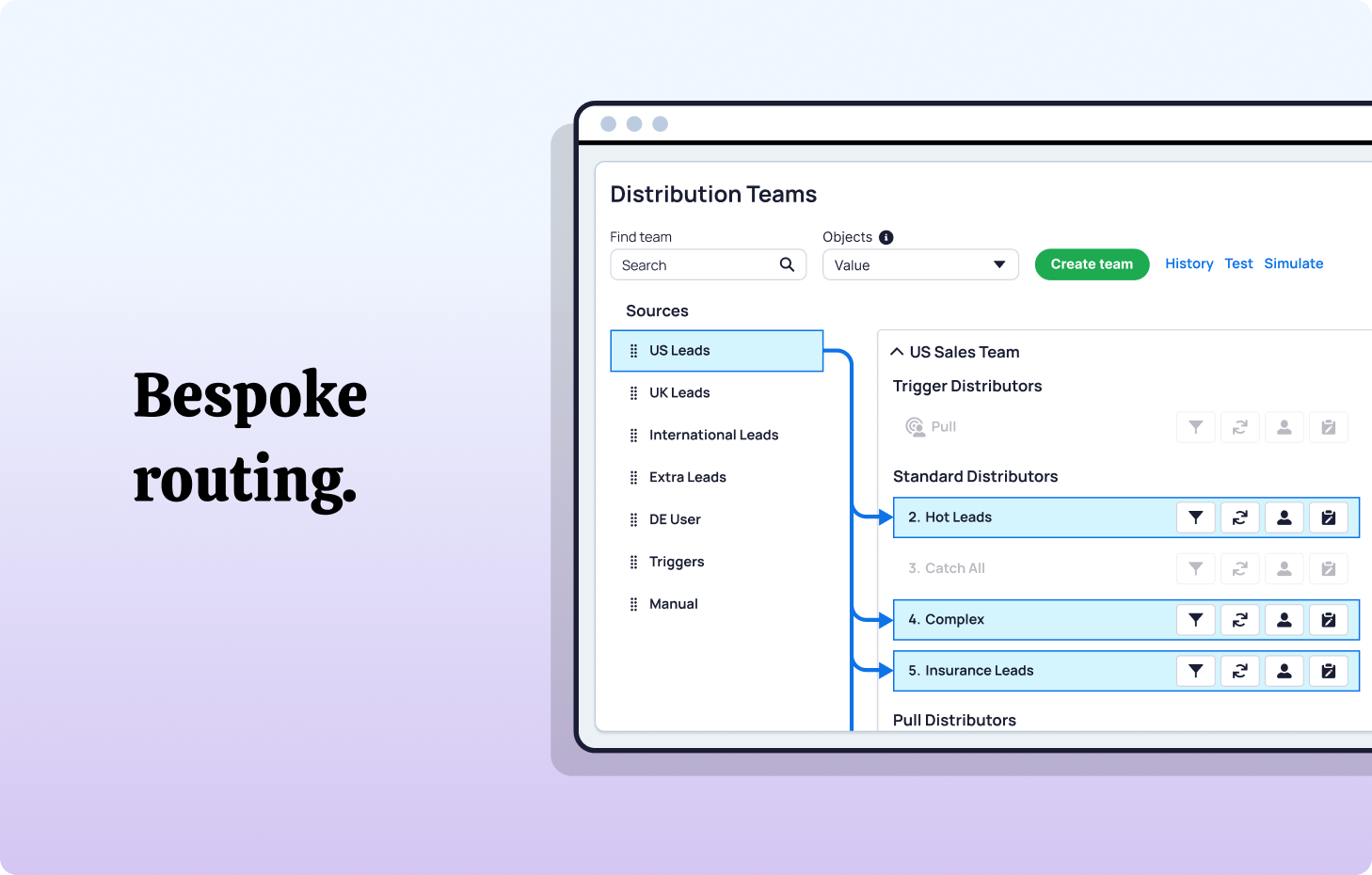
The takeaway
Your lead routing strategy matters, whether you need simple fairness or complex logic, the right approach ensures each and every lead is instantly assigned to the best rep for the job.
Micro-examples you can copy:
- EMEA Enterprise overflow to NA Enterprise during campaign weeks (keeps SLAs green).
- Ideal Customer Profile Score + Product: A-scores interested in Product B go to senior AEs; B-scores to SDRs for qualification.
- SLA safety net: if untouched after 10 minutes, reassign to “rapid response” queue for a first touch.
Measuring Success with KPIs.
Routing only matters if it delivers measurable impact. Track these key signals:
- Response time: AKA speed-to-lead, it’s how fast reps follow up after the lead comes in.. The quicker the reply, the higher the chance of qualifying and converting.
- Conversion rate: Proof your logic works. Right leads in the right hands close more often, showing the process is tuned to revenue goals.
- Sales cycle length: Optimized routing doesn’t just lift win rates-it shortens the path to closed-won. Faster cycles, with less chasing customers, means revenue sooner.
- Team productivity: Routing should cut admin, not add to it. Shutterstock saved 60 hours a week by automating case distribution with Distribution Engine-time reinvested in selling.
Customer satisfaction: When prospects meet the right rep instantly, they gain confidence fast. That strong first impression shapes the relationship and boosts renewal odds. Real teams see hard numbers move. Shutterstock removed ~60 hours of manual work per week by automating case distribution. Tebra consolidated lead and case assignment, reached 95% assignment accuracy, and lifted conversions by 30%. These aren’t vanity stats; they’re what happens when ownership is clear and speed is protected.
Conclusion: From Routing Chaos to Revenue Clarity.
Bad routing means lost deals, wasted time, and strained teams. A good lead routing system flips the script: real-time speed, fairness, and measurable growth.
That’s what NC Squared’s Distribution Engine delivers:
- Responsive: Reach buyers first with instant assignment and auto assign leads that aren’t contacted within their SLA
- Fair: You can’t argue with smart, rules-based routing logic. Keep workloads balanced and ditch the lead allocation spreadsheet!
- Accountable: Get real-time reports directly in Salesforce.
- Flexible: Self-serve on managing routing logic, sales territories, and rep availability without needing a Salesforce Admin or developer.
- Focused: We automate all the dedupe, matching and Salesforce admin so Sales can just focus on selling.
- 100% Salesforce-native: No new tools to log into and learn - all your data stays safe and secure in Salesforce.
The result: less firefighting, more revenue.
Ready to see it in action? Book a demo of NC Squared’s Distribution Engine and turn routing chaos into revenue clarity.
Fancy giving Distribution Engine a try?
Have a play around for free, or get in touch if you’d prefer to chat.
Take us for a spin with a 30 day Free Trial
Have a play around for free, or get in touch if you’d prefer to chat.
%20dark.avif)